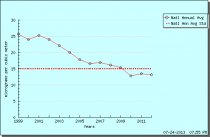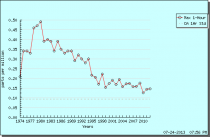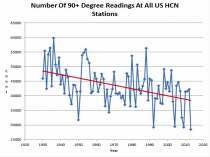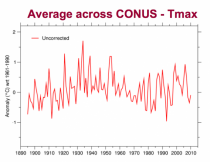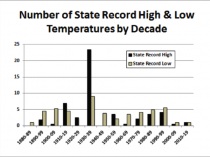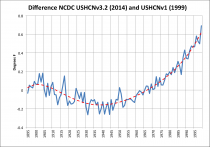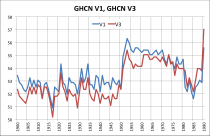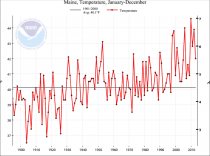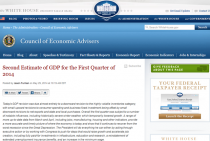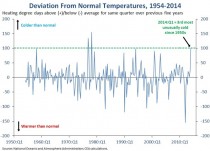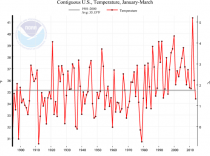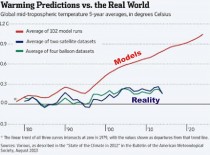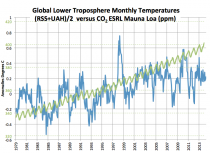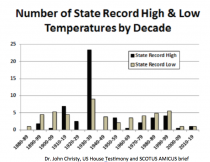The US-Africa Leaders Summit is ending, with many interesting observations about the continent’s future, the most memorable of which might be Secretary of State John Kerry’s suggestion that African nations should practice “climate-smart” agriculture...to accompany the Obama Administration’s determination that they also practice “climate-smart” electricity generation. In the real world, this would translate into “Develop and modernize, but not too much and only in line with our Deep Ecology policies” ... “generate electricity, but only what you can get from wind and solar power”...and “Increase food production, but only to the extent that you can do so without relying on biotechnology, chemical fertilizers or tractors.”
Africans would be crazy to buy into this scheme, even to secure foreign aid money being dangled in front of them. Indeed, their guiding principle should be this: Africans should not do what the United States is doing now that it is rich. It should do what the United States did to become rich.
Obama-Kerry policies would perpetuate energy poverty, malnutrition, disease and death
Paul Driessen
The 2014 US-Africa Leaders Summit hosted by President Obama this past week brought together the largest-ever gathering of African government officials in Washington, DC. They discussed ways to bolster trade and investment by American companies on a continent where a billion people including 200 million aged 15 to 24 are becoming wealthier and better educated.
They have steadily rising expectations and recognize the pressing need to create jobs, improve security, reduce corruption, and control diseases like Ebola, HIV/AIDS, tuberculosis and malaria. They also understand that better roads and air transportation, improved agriculture and nutrition, and far more energy especially electricity are the sine qua non to achieving their aspirations. Indeed, nearly 700 million Africans still do not have electricity or get it only sporadically, a few hours a day or week.
“The bottom line is, the United States is making a major and long-term investment in Africa’s progress,” Mr. Obama stated. One has to wonder whether his rhetoric matches his policy agenda and whether Africans would do well to remember the president’s assurances that Americans could keep their doctors, hospitals and insurance, when they hear his fine words and lofty promises for Africa.
The fact is, no modern economies, healthcare systems or wealth-building technologies can function in the absence of abundant, reliable, affordable electricity and motor fuels. They require far more than can possibly come from “climate-smart” wind, solar and biofuel sources. Adequate food and nutrition require modern agriculture. Eradicating malaria requires chemical insecticides, DDT and ACT drugs.
Obama Administration policies on all these matters are likely to hold Africa back for decades.
For President Obama, everything revolves around fears of “dangerous manmade climate change” and a determination to slash or end fossil fuel use. He has said electricity rates must “necessarily skyrocket.” His former Energy Secretary wanted gasoline prices to reach European levels: $8-10 per gallon. His EPA is waging a war on coal. And his own requirements would prevent Africa from modernizing.
In 2009, the president told Africans they should focus on their “bountiful” wind, solar, geothermal and biofuel resources, and refrain from using “dirty” fossil fuels. He signed an executive order, directing the Overseas Private Investment Corporation to ensure that any projects it finances reduce their greenhouse gas emissions by 30% by 2020. He launched a number of domestic and international climate initiatives.
Afterward, when Ghana asked OPIC to support a $185 million gas-fired electrical generator (that would utilize natural gas being flared and wasted at its oil production operations), OPIC refused to help. When South Africa sought a World Bank loan for its state-of-the-art Medupi coal-fired power plant (which will reduce dangerous pollutants 90% below what 1970s-era plants emitted), the White House “abstained” from supporting the loan. Thankfully, approval squeaked by anyway, and Medupi will soon be a reality.
Even more absurd and unethical, the White House announced last October that it will now oppose any public financing for coal-based power projects, except in the world’s poorest nations, unless they meet the draconian carbon dioxide emission standards now imposed on new coal-fired generators in the USA.
These policies prolong reliance on open fires fueled by wood and dung. They mean families are denied lights, refrigeration and other benefits of electricity, and millions die every year from lung and intestinal diseases, and other effects of rampant poverty. With hydrocarbons still providing 82% of the world’s energy and China, India and other rapidly developing countries building numerous coal-fired generating plants retarding Africa’s development in the name of preventing climate chaos is useless and immoral.
Meanwhile, President Obama is still guided by science advisor John Holdren, a fervent opponent of fossil fuels who infamously said the United States should support only the “ecologically feasible” development of poor countries, in line with his perceived “realities” of ecology and rapid energy resource depletion. How that translates into official policy can be seen from Mr. Obama’s 2013 remark: “Here in Africa, if everybody is raising living standards to the point where everybody has got a car, and everybody has got air conditioning, and everybody has got a big house, well, the planet will boil over.”
Secretary of State John Kerry’s inane recent statements are equally problematical for Africa. His fixation on “climate-smart” energy and agriculture suggests that he lives on another planet and cannot imagine life outside a $5-million mansion and certainly not life for destitute families in sub-Saharan Africa.
For proof of manmade climate change, Kerry told US Africa Summit attendees, one need only look at the “hotter temperatures, longer droughts and unpredictable rainfall patterns” that farmers must now deal with. Not only are global temperature trends flat for the past 18 years; actual records show clearly that drought and rainfall fluctuations are no different from what North American, African and other farmers have had to deal with for centuries. Moreover, increasing evidence suggests that the sun’s ongoing “quiet” period may portend several decades of markedly colder global temperatures.
Even more absurd, Kerry told attendees that “carbon pollution” is making food “less nutritious.” First, it’s not carbon (soot). It’s carbon dioxide, which makes food crops, trees and other plants grow faster and better, and survive better under adverse conditions like droughts. Second, hothouses routinely increase their CO2 levels to two or more times what is in Earth’s atmosphere, to spur crop growth. Are these German, Israeli and American tomatoes and cucumbers less nutritious than field-grown varieties? In fact, recent studies have found increased nutrient concentrations in food crops, thanks to higher CO2.
To the extent that “research” supports any of these ridiculous claims, it merely underscores what scientists will concoct when tempted by billions in government grants or intimidated by activists and colleagues who attack them as climate change “deniers” if they do not play the Climate Armageddon game.
Secretary Kerry did suggest that the best way to help farmers is through “climate-smart agriculture” and “creative solutions that increase food production.” But it’s a virtual certainty he did not mean any of the things that really would help: biotechnology, modern mechanized farming and chemical fertilizers.
Genetically engineered Golden Rice and bananas are rich in beta-carotene, which humans can convert to Vitamin A, to prevent childhood blindness and save lives. New Bt corn varieties both kill insect pests, dramatically reducing the need for pesticides, and enable corn (maize) plants to survive droughts. New rice varieties can survive prolonged submergence during monsoons and floods. These crops, modern hybrid seeds and chemical fertilizers multiply traditional yields many times over. Other developments let farmers practice no-till farming, which protects vital soil organisms and nutrients and reduces erosion.
These solutions won’t just improve adaptation to whatever climates might confront us in the future. They will also enable us to feed billions of people including some 250 million malnourished Africans without having to plow under millions of acres of wildlife habitat. However, Big Green activists in and out of government oppose GMO crops, fossil fuels and modern farming, whatever their benefits to humanity and regardless of the death and destruction that result when people are denied access to them.
Africa is blessed with abundant oil, gas and coal. Turning food into fuel would squander those resources and divert land, water, fertilizers and energy from feeding people to produce expensive fuels and leave people malnourished. This is not “climate-smart” energy or agriculture. It’s just plain stupid.
Wind and solar will let people in remote areas have light bulbs, tiny refrigerators and cell phone chargers, until they can be connected to an electrical grid. They cannot support modern economies, factories, shops, schools, hospitals or families. Coal, natural gas, nuclear and hydro-based electricity are essential.
Here is the real bottom line: Africans should not do what the United States is doing now that it is rich. It should do what the United States did to become rich.
Paul Driessen is senior policy analyst for the Committee For A Constructive Tomorrow (http://www.CFACT.org) and author of Eco-Imperialism: Green power - Black death.
What if the “green” movement isn’t saving the earth, but instead is enslaving humanity?
Prof. Matt Malkin, UCLA
BLUE is more than a film, it’s an idea. Ideas have the power to change the way we think, begin movements, and even change the world. One of the most prominent idea of our time today is the Green Movement, which says that the Earth is threatened by the activity, even the existence, of mankind, and that the noble response is to restrict our freedom in order to save the planet. The movie BLUE challenges that idea. BLUE is an independently funded and filmed documentary by director, JD King.
“In BLUE, filmmaker JD King takes you into some of the most spectacular forest lands in North America, and introduces you to many of the real people who have made their lives there for generations. They are now in a desperate battle to save everything they value, their land, their jobs, their families, their way of life. You may be shocked to discover that their worst enemy has become the ‘environmental’ movement. Do our new environmental governors really know what is best for these rich precious lands? To the contrary, JD King explores the reality underneath the rhetoric, and shows that this movement is no longer about humans’ proper conservancy of nature, but is all about seizing the new ‘green’ - of money, power and dictatorial control. Can rational rules for these lands--based on the human values of rights and freedom prevail? Some of the true stories you will see in this movie may outrage you, some of them will move and inspire you, but you will never take the claims and demands of ‘environmental leaders’ at face value again after experiencing BLUE.”
---------
Who’s really waging the ‘war on science?
Global warming alarmists constantly claim they are being “harassed” by climate chaos skeptics. The Climate Armageddon-istas proclaim they are victims, and the American Geophysical Union has even created a “Climate Science Legal Defense Fund,” to pay mounting legal bills that alarmist scientists like Michael Mann have incurred. But the real war on honest science and scientists is being waged by those who have garnered billions of taxpayer, foundation and corporate dollars for alarmist research, and thus have the most to lose when the public finally figures out what’s been going on. No wonder they are in a tizzy.
My article this week explores these issues - primarily by reviewing two cases where scientists really have been singled out, vilified and persecuted: Dr. Patrick Michaels from the University of Virginia, and Dr. David Legates at the University of Delaware.
Paul Driessen
Left-leaning environmentalists, media and academics have long railed against the alleged conservative “war on science.” They augment this vitriol with substantial money, books, documentaries and conference sessions devoted to “protecting” global warming alarmists from supposed “harassment” by climate chaos skeptics, whom they accuse of wanting to conduct “fishing expeditions” of alarmist emails and “rifle” their file cabinets in search of juicy material (which might expose collusion or manipulated science).
A primary target of this “unjustified harassment” has been Penn State University professor Dr. Michael Mann, creator of the infamous “hockey stick” temperature graph that purported to show a sudden spike in average planetary temperatures in recent decades, following centuries of supposedly stable climate. But at a recent AGU meeting a number of other “persecuted” scientists were trotted out to tell their story of how they have been “attacked” or had their research, policy demands or integrity questioned.
To fight back against this “harassment,” the American Geophysical Union actually created a “Climate Science Legal Defense Fund,” to pay mounting legal bills that these scientists have incurred. The AGU does not want any “prying eyes” to gain access to their emails or other information. These scientists and the AGU see themselves as “Freedom Fighters” in this “war on science.” It’s a bizarre war.
While proclaiming victimhood, they detest and vilify any experts who express doubts that we face an imminent climate Armageddon. They refuse to debate any such skeptics, or permit “nonbelievers” to participate in conferences where endless panels insist that every imaginable and imagined ecological problem is due to fossil fuels. They use hysteria and hyperbole to advance claims that slashing fossil fuel use and carbon dioxide emissions will enable us to control Earth’s climate - and that references to computer model predictions and “extreme weather events” justify skyrocketing energy costs, millions of lost jobs, and severe damage to people’s livelihoods, living standards, health and welfare.
Reality is vastly different from what these alarmist, environmentalist, academic, media and political elites attempt to convey.
In 2009, before Mann’s problems began, Greenpeace started attacking scientists it calls “climate deniers,” focusing its venom on seven scientists at four institutions, including the University of Virginia and University of Delaware. This anti-humanity group claimed its effort would “bring greater transparency to the climate science discussion” through “educational and other charitable public interest activities.” (If you believe that, send your bank account number to those Nigerians with millions in unclaimed cash.)
UVA administrators quickly agreed to turn over all archived records belonging to Dr. Patrick Michaels, a prominent climate chaos skeptic who had recently retired from the university. They did not seem to mind that no press coverage ensued, and certainly none that was critical of these Spanish Inquisition tactics.
However, when the American Tradition Institute later filed a similar FOIA request for Dr. Mann’s records, UVA marshaled the troops and launched a media circus, saying conservatives were harassing a leading climate scientist. The AGU, American Meteorological Society and American Association of University Professors (the nation’s college faculty union) rushed forward to lend their support. All the while, in a remarkable display of hypocrisy and double standards, UVA and these organizations continued to insist it was proper and ethical to turn all of Dr. Michaels’ material over to Greenpeace.
Meanwhile, although it had started out similarly, the scenario played out quite differently at the University of Delaware. Greenpeace targeted Dr. David Legates, demanding access to records related to his role as the Delaware State Climatologist. The University not only agreed to this. It went further, and demanded that Legates produce all his records = regardless of whether they pertained to his role as State Climatologist, his position on the university faculty, or his outside speaking and writing activities, even though he had received no state money for any of this work. Everything was fair game.
But when the Competitive Enterprise Institute filed a FOIA request for documents belonging to several U of Delaware faculty members who had contributed to the IPCC, the university told CEI the state’s FOIA Law did not apply. (The hypocrisy and double standards disease is contagious.) Although one faculty contributor clearly had received state money for his climate change work, University Vice-President and General Counsel Lawrence White claimed none of the individuals had received state funds.
When Legates approached White to inquire about the disparate treatment, White said Legates did not understand the law. State law did not require that White produce anything, White insisted, but also did not preclude him from doing so. Under threat of termination for failure to respond to the demands of a senior university official, Legates was required to allow White to inspect his emails and hardcopy files.
Legates subsequently sought outside legal advice. At this, his academic dean told him he had now gone too far. “This puts you at odds with the University,” she told him, “and the College will no longer support anything you do.” This remarkable threat was promptly implemented. Legates was terminated as the State Climatologist, removed from a state weather network he had been instrumental in organizing and operating, and banished from serving on any faculty committees.
Legates appealed to the AAUP - the same union that had staunchly supported Mann at UVA. Although the local AAUP president had written extensively on the need to protect academic freedom, she told Legates that FOIA issues and actions taken by the University of Delaware’s vice-president and dean “would not fall within the scope of the AAUP.”
What about the precedent of the AAUP and other professional organizations supporting Dr. Mann so quickly and vigorously? Where was the legal defense fund to pay Legates’ legal bills? Fuggedaboutit.
In the end, it was shown that nothing White examined in Legates’ files originated from state funds. The State Climate Office had received no money while Legates was there, and the university funded none of Legates’ climate change research though state funds. This is important because, unlike in Virginia, Delaware’s FOIA law says that regarding university faculty, only state-funded work is subject to FOIA.
That means White used his position to bully and attack Legates for his scientific views pure and simple. Moreover, a 1991 federal arbitration case had ruled that the University of Delaware had violated another faculty member’s academic freedom when it examined the content of her research. But now, more than twenty years later, U Del was at it again.
Obviously, academic freedom means nothing when one’s views differ from the liberal faculty majority or when they contrast with views and “science” that garners the university millions of dollars a year from government, foundation, corporate and other sources, to advance the alarmist climate change agenda. All these institutions are intolerant of research by scientists like Legates, because they fear losing grant money if they permit contrarian views, discussions, debates or anything that questions the climate chaos “consensus.” At this point, academic freedom and free speech obviously apply only to advance selected political agendas, and campus “diversity” exists in everything but opinions.
Climate alarmists have been implicated in the ClimateGate scandal, for conspiring to prevent their adversaries from receiving grants, publishing scientific papers, and advancing their careers. Yet they are staunchly supported by their universities, professional organizations, union and groups like Greenpeace.
Meanwhile, climate disaster skeptics are vilified and harassed by these same groups, who pretend they are fighting to “let scientists conduct research without the threat of politically motivated attacks.” Far worse, we taxpayers are paying the tab for the junk science and then getting stuck with regulations, soaring energy bills, lost jobs and reduced living standards… based on that bogus science.
Right now, the climate alarmists appear to be winning their war on honest science. But storm clouds are gathering, and a powerful counteroffensive is heading their way.
Paul Driessen is senior policy analyst for the Committee For A Constructive Tomorrow (http://www.CFACT.org) and author of Eco-Imperialism: Green power Black death.
---------
German scientists show that constant alarmist messages about dramatic and dangerously rising sea levels cannot be confirmed by raw tidal measurements.

According to expert Klaus-Eckart Puls “measurements are actually showing the opposite.” Only “mysterious” government computer models show rises in sea levels, says the report.tidal measure
Making the announcement on behalf of the European Institute for Climate and Energy Klaus-Eckart Puls says:
“Worldwide, neither tidal gauge data (200 years) nor satellite data (20 years) show any acceleration of sea level rise. That is in stark contrast to all past and current statements by the IPCC and several climate (research) institutes and climate-models. Moreover, there are indications that the satellite data (showing a higher [double] rate of increase) are significantly “over-corrected."” [See ref 28 in the report]
‘Mysterious Case or Data Rigging?
The European Institute for Climate and Energy expressed their concerns about the reliability of certain official computer models adding, “Instead of adjusting the satellite data to those actually measured on the ground and correcting them downward, the discrepancy between gauge and satellite measurements continue to this date. Somehow, that does not appear to bother anyone. A mysterious case.”
Wilhelmshaven coast scientist, Karl-Ernst Behre from the Lower Saxony Institute for Historical Coastal Research (NIHK ) explains that the best evidence shows sea levels have only been rising naturally “since the end of the last ice age we have good knowledge of the sea level changes on the German North Sea coast.”
The latest German research shows that sea level has risen naturally due to global warming by more than 50 meters in the past 10,000 years, says Behre. It has been nothing to do with humans.
“The increase has increasingly slowed when one considers the overarching trend of the last 3000 years. In the “youngest” 400 years (1600-2000) there have been (without the GIA correction) an increase of 1.35 m, in the past 100 years, only one such 25 cm, thus slowing it down further.”
No Evidence of Increased Floods
The European Institute for Climate are also able to confirm there is no evidence that the floods are getting worse. We have measured the flood levels for 100 years, during which time the mean high water is up by 25cm which fits the natural rise in sea level. There is no evidence of more frequent floods.”
Sea levels alone are not the only factor - changes in the landmass due to the rise and fall of geological movements, especially plate tectonics, volcanism and glacial processes can superficially affect sea levels (Isostasy and Eustasie).
Not helping the cause of alarmism is the fact well-known German land subsidence should be making any supposed sea level rise look even more pronounced, as the report shows.
As for the German North Sea coast Behre explains that in 2011, a work was published on the trends of 15 coastal levels in the German Bight. A graph (see below) detailing the findings shows the actual extent of sea level rises, proving no human signal. German sea level study.
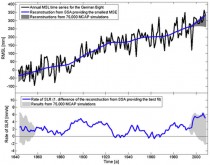
This was part of a wider range of studies dealing with the ongoing Holocene vertical land movements of the last millennium in southern Scandinavia, Jutland, the North Frisian Islands, the south arch over Denmark and the middle Baltic Sea. It proved:
“The North Sea basin is already a very long time an area of subsidence, tectonic subsidence and this holds true even today. The German coast lies on the upper part of this reduction area. In the area of the German Bight there is shown to be a tectonically induced mean decrease from 0.64 cm / century, in the West it is 0.54 cm / century as in the east and consequently is overall a small amount.”
As such, the authors are able to confirm there is no trend. All measured changes in sea levels can thus be attributed only to a natural origin consistent with the ongoing glacial retreat our planet has been experiencing since the onset of the Holocene Period around 11,000 years ago.
To read the full report vsit http://www.eike-klima-energie.eu
See more in part two of this panel
Broadcast live streaming video on Ustream
By Paul Dreissen
I had a surreal experience last week, being interrogated by a Greenpeace activist, on topics ranging from climate change to funding, an anti-Greenpeace protest… and something he really did not want to discuss: the lethal impacts of his organization’s policies on billions of impoverished, malnourished and diseased people around the world.
As I have noted many times previously, 2.5 billion people still do not have electricity or get it only sporadically, and so must burn wood and dung for heating and cooking. That results in widespread lung diseases that kill two to four million people every year. No electricity also means no refrigeration, safe water or decent hospitals, which means virulent intestinal diseases kill another two million annually.
Greenpeace and its fellow eco-imperialists are directly responsible for much of this misery and death. Their anti-technology, anti-people campaigns insist that the far-fetched and illusory risks of using modern marvels of electricity, insecticides biotechnology are worse than the life-threatening dangers those technologies would reduce or prevent.
---------
Greenpeace activist confirms every negative story you’ve ever read about this activist group
Paul Driessen
It was a surreal experience. As the Heartland Institute’s hugely successful Ninth International Conference on Climate Change ended, I agreed to let Greenpeace activist Connor Gibson interview me.
I’d just given a presentation on Big Green’s lethal agenda, describing how “dangerous manmade climate change” is just one of many mantras invoked by the Deep Ecology movement to advance an agenda that is anti-energy, anti-people, and opposed to modern economies, technologies and civilizations. As readers of my book and articles know, this unaccountable movement inflicts lethal consequences on millions of people every year - the result of malaria, malnutrition, lung and intestinal diseases, and other afflictions of rampant poverty imposed or perpetuated by unelected and unaccountable eco-imperialists.
“I read your book,” he told me, and attended some of the talks by globally renowned experts on climate, weather, species extinction, human health and other topics. If so, he obviously hadn’t listened, or had simply chosen to ignore every fact and explanation presented, as not in accord with his ideologies. That would certainly include the keynote address by Greenpeace cofounder Patrick Moore, explaining how he left the organization over its increasingly bizarre, irrational and inhumane attitudes and actions.
Gibson’s “interview” quickly became a prosecutorial interrogation, marked by ignorance or denial of basic facts and repeated interruptions to contest my observations. He insisted that hurricanes are more frequent and devastating than ever before (though not one Category 3 or higher ‘cane has made US landfall in eight-plus years, breaking a century-long record, as a panel discussion I had chaired that day made clear); wildfires are worsening (though their number and acres burned are down significantly, and could be driven lower via more intelligent forest management and fire suppression policies); and rising seas will soon drown coastal communities (hardly likely at the current rate of seven inches per century).
He likewise denied the 18-year pause in global warming, even though the IPCC and other alarmists have finally admitted it is real. My references to conference participants and the exhaustive NIPCC report were met with claims that it had not been peer-reviewed. Perhaps not by the closed circle of well-funded IPCC scientists, bureaucrats and activists who rubberstamp one another’s work, while refusing to share data and methodologies, allow outside experts to review their work products, attend Heartland conferences, or debate NIPCC scientists in any forum. (Alarmists know their data, claims, conclusions and economy-killing demands cannot withstand scrutiny.) However, the NIPCC reports and the studies they laboriously analyze and summarize were fully peer-reviewed by numerous scientists.
(Alarmists say twenty years of warming proves Earth is at a “tipping point’ for runaway climate chaos, requiring the end of fossil fuels. They say the subsequent 18 years of no warming, and even a slight cooling, is irrelevant and meaningless. Whom do you believe, they ask? Us alarmists and our computer models, or a bunch of “fringe” scientists who cite actual temperature and other evidence?)
After twenty minutes, Gibson got to his real issue: money. Where does CFACT get its funding? The Koch brothers and ExxonMobil? That would be nice, to compliment the cash that Exxon gives to radical green groups. But no, they don’t support us. My mention of Chesapeake Energy’s $26 million to the Sierra Club, to fund anti-coal campaigns, did force him to admit this is a problem for Big Green’s social responsibility mantra. But when I noted Tom Steyer’s billions from hedge fund investments in coal mines and power plants, Gibson insisted that this money was second-hand and thus pure, whereas Koch money was earned directly (via producing energy and creating jobs) and thus was tainted by “self-interest.”
That “ethical” distinction without a difference would also apply, I suppose, to the tens of millions of dollars that Greenpeace and the Greenpeace Fund have received from fat-cat liberal foundations that are heavily invested in fossil fuel and other corporate securities.
Gibson also brought up his organization’s attempted 2003 anti-chemicals rally in New Jersey’s Liberty Park. The event turned into a resounding protest against Greenpeace, when scores of black and Hispanic demonstrators from the Congress of Racial Equality completely flummoxed the Rainbow Warriors with stilt walkers, bongo drums and chants of “Hey hey Greenpeace, what do you say? How many children did you kill today?” He dropped his inquisition when I pointed out that I’m a life-member of CORE.
Indeed, what Gibson really did not want to discuss were the destructive, even lethal effects of Greenpeace policies and campaigns. Some 2.5 billion people still do not have electricity or get it only sporadically, and so must burn wood and dung for heating and cooking, which results in widespread lung diseases that kill two to four million people every year. No electricity also means no refrigeration, safe water or decent hospitals, which means virulent intestinal diseases kill another two million annually.
Worldwide, some two billion people still live in malaria-infested areas, 500 million get the disease every year, and nearly a million die. A primary reason is their inability to acquire insecticides to kill mosquitoes and DDT to keep the flying killers out of homes. Another billion people face malnutrition and Vitamin A deficiency that causes blindness and death in children. In fact, eight million children have died from Vitamin A deficiency since Golden Rice was invented and made available at no charge to poor farmers.
But the Rainbow Warriors and other callous eco-imperialists wage well-funded campaigns against Golden Rice, insecticides and DDT, and coal-fired, gas-fueled, hydroelectric and nuclear power generation, perpetuating poverty, malnutrition, disease, misery and death. To them, a planet free from the wildly conjectural and exaggerated dangers of these technologies is far more important than the billions of lives improved and millions of lives saved by them. It is a vicious war on dark-skinned women and children, who die in the greatest numbers from malaria, lung infections, malnutrition and severe diarrhea.
Greenpeace actions are akin to denying chemotherapy to cancer patients or antibiotics to pneumonia sufferers. Their anti-technology campaigns are eco-manslaughter and should no longer be tolerated.
Personally, I cannot imagine life without modern technologies. I can’t imagine living in electricity-free, disease-ridden, malnourished, polluted poor nation squalor. As my grandmother used to tell me, “The only good thing about the good old days is that they’re gone.”
But of course, Gibson has an air-conditioned malaria-free home, fine food, access to affordable, reliable electricity and transportation, a refrigerator, video camera and cell phone. He would never give them up, nor would I ask him to. However, some of my African friends would gladly let him “enjoy” a few months in a state-of-the-art, mosquito-infested hut, rely solely on a bed net, drink parasite-infested water, breathe polluted smoke from cooking fires, and walk miles to a clinic when he gets malaria, TB or dysentery - hoping the nurse has some non-fake medicines to treat him. I’d gladly help make the arrangements.
Financially motivated innovators, entrepreneurs and companies have worked wonders to improve and save the lives of billions. Yes, there have been accidents, some of which have killed hundreds of people or thousands of animals. However, the real killers are governments and anti-technology nonprofit activist corporations. Their death tolls are in the million, via wars and through misguided or intentional policies that institute or perpetuate starvation and disease from denial of food and life-saving technologies.
Gibson is a bright guy. Perhaps one day he will understand all of this, hopefully before the death toll rises much higher. To that end, he and his alarmist colleagues would profit mightily from reading my Eco-Imperialism book and new report Three Faces of Sustainability; the new book About Face: Why the world needs more carbon dioxide; and several recent studies: Climate Change Reconsidered: Physical Science; CCR: Biological Impacts, and Climate Catastrophe: A superstorm for global warming research.
Countless jobs, living standards and lives hang in the balance. The eco-imperialist crimes against humanity must end.
Paul Driessen is senior policy analyst for the Committee For A Constructive Tomorrow (http://www.CFACT.org) and author of Eco-Imperialism: Green power Black death. See Icecap Amazon Book Store
See more of the havoc being created by the green groups on our sister site http://redneckusa.wordpress.com/
By Joseph D’Aleo, CCM
Last winter was a brutally cold one for the nation’s midsection. For Chicago, the period from December through March was the coldest in the entire record back to 1872. It was the third snowiest winter behind only the 1978/79 and 1977/78 winters. In Detroit, it ended up the snowiest ever on record back to 1880. It now has been cooling in the US (including all 9 climate zones) for 20 winters (2.26F)!
Weatherbell called for this harsh winter even as NWS and many forecasters called for a warm winter.
It has been a cool spring and summer in the central. Now as we approach the peak of summer, a very strong trough for summer and cold air mass for July will be driving into the central and east.
The warm pool of water in the North Pacific (the same driver for last winter) and the warm tropical Pacific waters moving west to the central Pacific is a classic scenario for a very cold winter in the central and eastern US. The warm water off the west coast usually leads to a cooler, wetter summer in the central as we forecast.
The combination of that warm pool, an El Nino Modoki (what we call that central Pacific biased El Nino), and the other natural climate drivers we look at, suggest this next winter will be like last one but with the cold biased further east. This has scary potential consequences because of the regulations imposed by the EPA this year.
Last winter, residents of many parts of the north paid as much for electricity as in all of 2012. Some power plants came within two days of running out of oil in New England. During the winter of 2014, coal was the only fuel with the ability to meet demand increases for electricity, providing 92 percent of incremental electricity in January/February, 2014 versus the same months in 2013.
With the projected closure of 60 gigawatts (GW) of coal plant capacity, virtually the entire U.S. is rapidly reaching the brink of significantly higher prices for electricity and being unable to meet either the summer or winter peak demand for power. Unless immediate steps are taken to halt coal plant closures. (Institute for Energy Research Study)
In a major cold outbreak, the grid may fail and large areas may be in the dark during extreme cold. The 1989 blackout from a failure of the Canadian grid may be a preview of our situation for which politicians will likely blame power companies instead of their own bad policy/regulations.

This is a student in India studying in a blackout. Will this be the US next winters and in our future thanks to the EPA?
Long blackouts may mean your pipes freeze. If they burst, it can cost thousands to repair. Even without blackouts, energy bills will continue to rise higher, perhaps much higher than 2013/14. High energy costs increase the cost of transportation impacting commuters and the cost of all goods and services (see Gallup), putting an enormous strain on those on fixed incomes, the poor and middle class. High costs of fuel and food will affect school budgets, restaurants, businesses and retailers, which may mean more part time labor and staff cutbacks, putting more families in financial distress. Yes, one little pen and an EPA run amuck can have far reaching effects.
The irony it is a real threat in the forseeable future, not one envisioned by failing climate models, 100 years away.
See some of the records set this week here.
Join Joe Bastardi, Ryan Maue, Tom Downs and I at weatherbell.com to follow the evolution of another winter to remember.
See the long compiled list of scientists who believe a cooling from minor to major here.
Watch the keynote addresses starting Tuesday AM by Patrick Moore and John Coleman
Broadcast live streaming video on Ustream
Broadcast live streaming video on Ustream
Broadcast live streaming video on Ustream
See all the talks here , including Monday night by Joe Bastardi and Hon Dana Rohrabacher and Wednesday noon by Lord Monckton.
More to follow. Been here in Las Vegas the last three days. Over 600 attendees!
Some very fair media and some unfriendly media - CNN. I will have much more to say but trying to catch up. It was a working trip for Joe Bastardi and I as we had to keep all out regular Weatherbell.com forecasts out on schedule while participating
---------
Four Reasons Why 400 ppm CO2 Is Not A Problem

The Sky Fell last month, but almost nobody noticed.
The sky fell on Hawaii last month, all because carbon dioxide levels peeped above the much-hyped 400 ppm hurdle. Chicken Littles all over the world squawked into their friendly media megaphones about numerous imminent global warming disasters. One warned: “the fate of the world hangs in the balance.” (Similar alarms were rung when the 350 ppm level was passed).
But nobody else noticed anything scary.
Four pieces of well-established evidence say that 400 ppm of carbon dioxide in the atmosphere is not a concern.
Firstly, there has been no increase in global temperatures since 1998 despite 16 years of rising carbon dioxide levels and heavy usage of carbon fuels. Clearly, CO2 is not the main driver of global temperatures.
Secondly, the ice core records show clearly, with no exceptions, that all recent ice ages have commenced when the atmosphere contained relatively high levels of carbon dioxide. The temperature fell first, and then carbon dioxide levels fell. This proves that high carbon dioxide levels do not guarantee a warm globe, but could suggest that they may be a harbinger of a coming ice age. Ice will cause far more damage to the biosphere than the even the worst warming forecast.
Thirdly, current levels of atmospheric carbon dioxide are not extreme or unusual. Carbon dioxide reached 2,000 ppm in the luxuriant era of the dinosaurs, and ten times current levels (4,000 ppm) when the great Devonian coral reefs were flourishing. There is no tipping point into runaway global warming, or we would have tipped eons ago.
Finally, current carbon dioxide levels are just above starvation levels for plants. All vegetation would grow stronger, faster, and be more drought resistant and heat resistant if carbon dioxide levels trebled to 1,200 ppm. Such levels are no threat to humans, US submarines operate at up to 8,000 ppm for cruises of 90 days. Topping 400 ppm should be a cause for celebration, it shows that Earth is emerging from the cold hungry years of the ice ages.
Climate Cassandras have blown false trumpets once again.
Viv Forbes,
Rosewood Qld Australia
forbes@carbon-sense.com
-------
From ABC: Legislation to scrap the carbon tax has passed the Federal Parliament in a major win for the Abbott Government. After a lengthy debate, the Senate voted to get rid of the price on carbon, with 39 senators voting for and 32 voting against. This was the Government’s third attempt to scrap the tax since the election. the first two were rejected by the Senate.
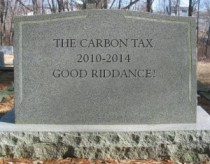
Lord Monckton discusses the evolution of the environmental movement.
-------
By Paul Dreissen
Poor countries should hold Big Green groups and directors liable for deaths, ravage they cause PDF
Big Green environmentalist groups demand that companies be honest, transparent, socially responsible and accountable for their actions. Eco-activists want corporate executives held personally liable for funding climate change skepticism and policies that the activists claim would prevent global warming. What if the same standards were applied to them?
Canada yanked Greenpeace’s tax-exempt status because of its false claims and intense political lobbying. India recently banned direct foreign funding of local campaign groups by foreign NGOs like Greenpeace that are helping to perpetuate poverty, misery and disease. They could do a lot more, to compel radical anti-development, anti-people corporations to be honest, transparent, socially responsible and accountable themselves.
That’s the “radical” idea advanced in my article today: what countries (and US states, AGs and citizen groups) can do to hold these radicals accountable, improve lives and make the world a better place.
By Paul Driessen
Fossil fuel and insurance company executives “could face personal liability for funding climate denialism and opposing policies to fight climate change,” Greenpeace recently warned several corporations. In a letter co-signed by WWF International and the Center for International Environmental Law, the Rainbow Warriors ($155 million in 2013 global income) suggested that legal action might be possible.
Meanwhile, the WWF ($927 million in 2013 global income) filed a formal complaint against Peabody Energy for “misleading readers” in advertisements that say coal-based electricity can improve lives in developing countries. The ads are not “decent, honest and veracious,” as required by Belgian law, the World Wildlife ethicists sniffed. Other non-governmental organizations (NGOs) make similar demands.
These are novel tactics. But the entire exercise might be little more than a clever attempt to distract people from developments that could create problems for thus far unaccountable Big Green organizations.
I don’t mean Greenpeace International’s $5.2 million loss a couple weeks ago, when a rogue employee (since fired) used company cash to conduct unauthorized trades on global currency markets. Other recent events portend far rougher legal and political waters ahead for radical eco-imperialists, especially if countries and companies take a few more pages out of the Big Green playbook.
India’s Intelligence Bureau recently identified Greenpeace as “a threat to national economic security,” noting that these and other groups have been “spawning” and funding internal protest movements and campaigns that have delayed or blocked numerous mines, electricity projects and other infrastructure programs vitally needed to create jobs and lift people out of poverty and disease. The anti-development NGOs are costing India’s economy 2-3% in lost GDP every year, the Bureau estimates.
The Indian government has now banned direct foreign funding of local campaign groups by foreign NGOs like Greenpeace, the WWF and US-based Center for Media and Democracy. India and other nations could do much more. Simply holding these uber-wealthy nonprofit environmentalist corporations to the same ethical standards they demand of for-profit corporations could be a fascinating start.
Greenpeace, WWF and other Big Green campaigners constantly demand environmental and climate justice for poor families. They insist that for-profit corporations be socially responsible, honest, transparent, accountable, and liable for damages and injustices that the NGOs allege the companies have committed, by supposedly altering Earth’s climate and weather, for example.
Meanwhile, more than 300 million Indians (equal to the US population) still have no access to electricity, or only sporadic access. 700 million Africans likewise have no or only occasional access. Worldwide, almost 2.5 billion people (nearly a third of our Earth’s population) still lack electricity or must rely on little solar panels on their huts, a single wind turbine in their village or terribly unreliable networks, to charge a cell phone and power a few light bulbs or a tiny refrigerator.
These energy-deprived people do not merely suffer abject poverty. They must burn wood and dung for heating and cooking, which results in debilitating lung diseases that kill a million people every year. They lack refrigeration, safe water and decent hospitals, resulting in virulent intestinal diseases that send almost two million people to their graves annually. The vast majority of these victims are women and children.
The energy deprivation is due in large part to unrelenting, aggressive, deceitful eco-activist campaigns against coal-fired power plants, natural gas-fueled turbines, and nuclear and hydroelectric facilities in India, Ghana, South Africa, Uganda and elsewhere. The Obama Administration joined Big Green in refusing to support loans for these critically needed projects, citing climate change and other claims.
As American University adjunct professor Caleb Rossiter asked in a recent Wall Street Journal article, “Where is the justice when the U.S. discourages World Bank funding for electricity-generation projects in Africa that involve fossil fuels, and when the European Union places a ‘global warming’ tax on cargo flights importing perishable African goods?”
Where is the justice in Obama advisor John Holdren saying ultra-green elites in rich countries should define and dictate “ecologically feasible development” for poor countries? As the Indian government said in banning foreign NGO funding of anti-development groups, poor nations have “a right to grow.”
Imagine your life without abundant, reliable, affordable electricity and transportation fuels. Imagine living under conditions endured by impoverished, malnourished, diseased Indians and Africans whose life expectancy is 49 to 59 years. And then dare to object to their pleas and aspirations, especially on the basis of “dangerous manmade global warming” speculation and GIGO computer models. Real pollution from modern coal-fired power plants (particulates, sulfates, nitrates and so on) is a tiny fraction of what they emitted 40 years ago and far less harmful than pollutants from zero-electricity wood fires.
Big Green activists say anything other than solar panels and bird-butchering wind turbines would not be “sustainable.” Like climate change, “sustainability” is infinitely elastic and malleable, making it a perfect weapon for anti-development activists. Whatever they support is sustainable. Whatever they oppose is unsustainable. To them, apparently, the diseases and death tolls are sustainable, just, ethical and moral.
Whatever they advocate also complies with the “precautionary principle.” Whatever they disdain violates it. Worse, their perverse guideline always focuses on the risks of using technologies - but never on the risks of not using them. It spotlights risks that a technology - coal-fired power plants, biotech foods or DDT, for example might cause, but ignores risks the technology would reduce or prevent.
Genetically engineered Golden Rice incorporates a gene from corn (maize) to make it rich in beta-carotene, which humans can convert to Vitamin A, to prevent blindness and save lives. The rice would be made available at no cost to poor farmers. Just two ounces a day would virtually end the childhood malnutrition, blindness and deaths. But Greenpeace and its “ethical” collaborators have battled Golden Rice for years, while eight million children died from Vitamin A deficiency since the rice was invented.
In Uganda malnourished people depend as heavily on Vitamin A-deficient bananas, as their Asian counterparts do on minimally nutritious rice. A new banana incorporates genes from wild bananas, to boost the fruit’s Vitamin A levels tenfold. But anti-biotechnology activists repeatedly pressure legislators not to approve biotech crops for sale. Other crops are genetically engineered to resist insects, drought and diseases, reducing the need for pesticides and allowing farmers to grow more food on less land with less water. However, Big Green opposes them too, while millions die from malnutrition and starvation.
Sprayed in tiny amounts on walls of homes, DDT repels mosquitoes for six months or more. It kills any that land on the walls and irritates those it does not kill or repel, so they leave the house without biting anyone. No other chemical at any price can do all that. Where DDT and other insecticides are used, malaria cases and deaths plummet by as much as 80 percent. Used this way, the chemical is safe for humans and animals, and malaria-carrying mosquitoes are far less likely to build immunities to DDT than to other pesticides, which are still used heavily in agriculture and do pose risks to humans.
But in another crime against humanity, Greenpeace, WWF and their ilk constantly battle DDT use, while half a billion people get malaria every year, making them unable to work for weeks on end, leaving millions with permanent brain damage, and killing a million people per year, mostly women and children.
India and other countries can fight back, by terminating the NGOs’ tax-exempt status, as Canada did with Greenpeace. They could hold the pressure groups to the same standards they demand of for-profit corporations: honesty, transparency, social responsibility, accountability and personal liability. They could excoriate the Big Green groups for their crimes against humanity and penalize them for the malnutrition, disease, economic retractions and deaths they perpetrate or perpetuate.
Actions like these would improve billions of lives and bring some accountability to Big Green(backs).
Paul Driessen is senior policy analyst for the Committee For A Constructive Tomorrow (http://www.CFACT.org) He is author of Eco-Imperialism; Green Power, Black Death> Buy it here at the Icecap Amazon store

Also see this very similar and powerful OP ED by Francis Mention. These should get you mad enough to spread the word and push back against these eco fanatics. Make sure your children who have been misled by those with good intentions but lacking the facts in schools for decades read the truth.
See Paul Dreissen and Cal Beisner in this Heartland ICCC9 panel.
Broadcast live streaming video on Ustream
See Dr. Patrick Moore co-founder of Greenpeace and world’s first ecologist tell you how he left Greeenpeace after 15 years when they became radicalized and anti humanity.
Broadcast live streaming video on Ustream

I was invited by the METSUL to speak in Brazil to farmers at a precision ag conference in 2010 during the World Cup. I was in beautiful Gramada for the semi finals which Brazil lost. I had the good fortune to spend time with meteorologist Eugenio Hackbart and his principal scientist Alexandre Aguiar, both well respected in southern Brazil’s Rio Grande do Sul (Porte Allegre). Eugenio responded to a typical Climate Central (affiliated with the increasingly not to be trusted Weather Channel which recently had a special report on the 10 ways the climate is different than 30 years ago - I ask anyone to respond to that nonsense and I will post) unscientific post on how Brazil has warmed. They list it under the category science but TWC sadly doesn’t do science much anymore it should be under the category of propaganda. JoeD
Dear Brian
Editor - Climate Central
Regarding your story on climate change and the World Cup.
I would like to stress some points and seek some scientific clarifications:
(1) I cannot understand the warming graphic supposed to reflect the climate reality of an entire country that has an area of continental proportions. How many stations were considered to produce the graphic ? And does the graphic consider the fact that a vast portion of Northern Brazil is forest area with very sparse meteorological readings ? Did you use extrapolations to produce it ? How many weather stations records were used to calculate that warming ? Below is a series of temperature charts generated by NASA’s GISS showing a cooling trend in the last decade in several weather stations in Brazil, from South to North, from West to East.
(2) In your article, do you consider the fact that Brazil experiences a massive process of urbanization in the last 50 years and that many of the weather stations in the cities and airports are now much more impacted by Urban Heat Island (UHI) than in the past ? Brasilia, the capital of Brazil, for example, was built in the late 50’s and didn’t exist before 1961.
(3) The winter in Southern Brazil, the coldest part of the country, was in average colder in the last five years than the 1931 to 1960 and 1961 to 1990 averages, mostly in the southernmost state of Rio Grande do Sul. Crops experienced heavy losses due to earlier (fall) and later (spring) than normal frost occurrences. It was not an isolated harsh winter or two, but a sequence of colder winters since the PDO flipped to mainly negative with frequent La Nina events.
(4) The winter of 2013 in Southern Brazil was the snowiest in decades. Some areas saw the highest snowfall since 1965, contrary to many climate change forecasts that the region would have a “snow drought”. Curitiba, one of the venues for the World Cup, saw snow last year for the first time since 1975. Roads were blocked by snow and some cities had roof collapses due to the amount of snow, even one foot in some towns. Even reports of thundersnow surfaced. Extraordinary and amazing photos of the snow storms of July and August 2013 in Brazil (yes I said Brazil) can be seen in the links below:
These are my questions and considerations regarding your article.
Best wishes,
Eugenio Hackbart
Chief Meteorologist
MetSul Meteorologia
Thank you Eugenio for providing sanity and enlightenment in the increasing Climate Dark Ages under world politically driven eco evangelism that has spread to virtually all the media including TWC, our once honorable universities and professional societies. Speaking of the enviro La La land, I gave a one hour talk at a NH Science, Technology and Energy Committee meeting following an hour from a Union of Concerned Scientist UNH professor. He started out by saying he was not a modeler but a data guy so would focus on data then spent most of the hour talking about data FROM THE MODELS. He showed a list of papers (Oreskes, UIL, Cook) that showed 97% of real scientists agreed with him and that I would represent the 3%. I followed by dismembering all his arguments and could tell from the look on the face of the true believers there (many benefiting from green energy or sustainability programs) they were uncomfortably suffering from cognitive dissonance. The professor was heard mumbling to himself through my talk. I would post my PPT it but the size is too large for Icecap. If you know my address write me and I will send it for your use.
By Steve Goreham
Originally published in Communities Digital News
Hydraulic fracturing, or fracking, a technique to remove natural gas and oil from shale formations, has been under withering assault from environmental groups for much of the last decade. Fracking has been blamed for contamination of drinking water, air pollution, earthquakes, water shortages, global warming, radiation discharge, and even cancer. But it appears that environmentalists have lost the battle against fracking.
Environmental groups have been almost unanimously opposed to hydraulic fracturing. Greenpeace and the Sierra Club favor outright bans, and other organizations call for tight controls on the process. According to the Sierra Club website, “‘Fracking’, a violent process that dislodges gas deposits from shale rock formations, is known to contaminate drinking water, pollute the air, and cause earthquakes. If drillers can’t extract natural gas without destroying landscapes and endangering the health of families, then we should not drill for natural gas.”
But the case against hydraulic fracturing is weak. Shale is typically fractured at depths greater than 5,000 feet, with thousands of feet of rock between the fractured area and the water table, which is located near the surface. When properly designed, fracking wells are lined with multiple layers of steel and cement casing to prevent leakage of water and natural gas into the local water supply. Approximately one million wells have been hydraulically fractured over the last six decades without cases of water contamination. During Congressional testimony in 2011, Environmental Protection Agency administrator Lisa Jackson stated, “I am not aware of any proven case where the fracking process itself has affected water, although there are investigations ongoing.”
Earthquakes caused by hydraulic fracturing appear to be minimal. Only a handful of micro quakes have been linked to fractured wells. None of these quakes have caused damage and most are too weak to feel. Nor is there evidence to show that fracking poses greater air pollution, radiation discharge, or cancer impact than agriculture, other mining, or other common industrial processes
Burning natural gas releases carbon dioxide, like any other combustion. Climate activists oppose natural gas as a planet-warming fossil fuel and therefore oppose fracking. But gas combustion releases about half the carbon dioxide of coal combustion. The majority of the decline in US carbon dioxide emissions over the last ten years is due to the switch of electric utilities from coal to natural gas fuel, not from the growth of renewables.
_thumb.jpeg)
Arguments about pollution of drinking water, earthquakes, water usage, radiation, and cancer appear to be a smoke screen to protect renewable energy, the sacred cow of the environmental movement. Natural gas from hydraulic fracturing is a direct threat to the growth of wind and solar energy.
Gas-fueled power plants are low-cost and dispatchable. In contrast, wind and solar electricity is two to three times the price and plagued by intermittent output, unable to respond to varying electrical demand. With hundreds of years of natural gas available from hydraulic fracturing and horizontal drilling techniques, why build another wind turbine?
Fracking opposition has been strong in isolated locations across the world. Bans or moratoriums are in place in Bulgaria, France, Germany, and South Africa. Protesters are blocking fracking operations in England and Poland. Selected US counties and communities have imposed fracking bans. The state of New York established a fracking moratorium in 2008 and has delayed approval of fracking for more than five years. Ironically, natural gas provides a growing majority of New York’s energy consumption.
Despite the opposition, it appears that environmental groups have lost the battle against fracking. In 2012, 40 percent of US natural gas production was shale gas, using fracking technology, up from less than one percent in 2000. Shale gas is projected to exceed 50 percent of production by 2040. US crude oil production is also surging due to oil recovered from shale fields, up more than 50 percent since 2005.
In Europe, concerns about energy dependency on Russia have triggered a turnaround of government opposition to fracking. Germany is preparing a framework for tapping oil and gas by hydraulic fracturing and planning to lift its ban. The British government is proposing policies to remove roadblocks from fracking efforts.
The Obama administration, despite its campaign to fight climate change, publically supports hydraulic fracturing and liquefied natural gas exports. Climate hawks, such as Senator Mark Udall of Colorado, also support the expansion of natural gas, to the dismay of green organizations. Governor Jerry Brown of California presses for action on climate change, but has not opposed hydraulic fracturing.
Today, hydraulic fracturing is underway in 21 states. Several more states are developing supporting regulations. Despite a number of local bans, fracking is now a frequently used industrial process across the nation.
Shale gas and oil are here to stay. Weak environmental arguments to ban fracking are being overwhelmed by the irresistible economic bonanza of low-cost energy.
Steve Goreham is Executive Director of the Climate Science Coalition of America and author of the book The Mad, Mad, Mad World of Climatism: Mankind and Climate Change Mania.
It is a litany of lies. It starts with the claim that scientists agree man is responsible for warming that is accelerating and due to man’s production of carbon pollution is (or will be) increasing asthma and other health problems.
First of all carbon pollution is ‘soot’ which we don’t have a problem with - the EPA’s own data shows in fact it is well below EPA standards, declining 50% since 1999. CO2 which is conflated with soot is a harmless (actually beneficial) gas and every breathe every human emits 100 times as much CO2 as is in ambient air. CO2 is critical for plant life and we are at the low end of the scale of CO2 for the earth’s history just above the survival level needed for plants which require it for photosynthesis - around 280 ppm.
Second its ozone not CO2 that presents a health hazard when it is produced near the ground in the cities from nitrous oxide and hydrocarbons in sunlight on hot days when there is little mixing of air. This was a problem in places like the LA Basin where a marine layer just above the surface formed an inversion trapping low level air. Ozone levels have declined even more rapidly that particulates thanks to catalytic converters and more efficient combustion removing hydrocarbons and converting toxic NO to NO2. An air quality alert day in LA has become rare.
Third the number of hot days has declined not increased.
It is during the day that smog forms and you can see that lack of accelerated warming in the average TMAX (Maximum Temperatures) for US stations.
How about the warming they claim is happening?
It is not there in the state records with 23 of the 50 all time highs in the 1930s and 8 before 1960 with more state lows than highs since the 1940s.
Most of the warming is in the ‘adjustments’ to the data. See example here. See in this graph the adjustments made to the data in the latest data set to the data from 1999. There has been an artificial cooling of the early century and warming of the post 1960s.
It is even more blatant in the global data sets. First a plot of the version 1 and version 3.
The difference is astounding, basically accounting for all the warming claimed for the globe for that period, accomplished by a major cooling of the early record and adjustments up later.
It is now into the state data. I was working on Maine for a presentation made a few years back and downloaded this from NOAA NCDC. Note how 1913 was the warmest year followed a century later with a bookend spike in 2012. The trend was essentially 0 since 1895 (-0.03/decade)
This last month, NCDC announced a new data set would replace the USHCN at Climate at a Glance. Here is Maine annual temperatures now. Note 1913 is hardly visible with a cooling of as much as 5F of the early century. Any wonder why every month ranks which the compliant media gladly reports on.
This creative accounting would put people in jail in the private sector. In the government it is a tool to manipulate public opinion.
Even the EPA Inspector general accused the EPA of not doing diligence and their own independent analysis for the Endangerment Finding on which the regulations are based (something the DC Circuit Court would not allow into the record in the appeals process) and recently that they were operating with fraudulent data for their claims about health impacts. I still remember the American Lung Association ads before the election in 2012 with the baby carriage in front of congress with a coughing child. I have had asthma since I was a young child and looked up to the ALA. The ALA received millions from the administration and EPA member was on the Board of Directors. The science did not support the linkage. Who can you trust nowadays???
The idea that by increasing the cost to energy producers, electricity prices will go down is lunacy. In her press conference Gina McCarthy said some people say the EPA energy plan will cause electricity prices to skyrocket and that wasn’t true. Well one of the first to promise it would cause electricity prices to skyrocket was President Obama himself.
The Chamber of Commerce warned in a report last week the new regulations on carbon emissions will cost the economy an average of $51 billion and 224,000 jobs each year through 2030 (a total of $765B and 3,360,000 jobs). And when the cost of energy goes up so does the cost of all goods and services as the costs of production and transportation rise. Everyone wants clean air and water and we have made enormous progress on both fronts. The new regulations will inflict great pain for little or no gain. It is government run amuck. This enviro driven frenzy almost destroyed Europe before the people and government began pushing back. These agencies like the EPA are acting with powers not enumerated in the constitution and the checks and balances from the legislative and judicial branches aren’t working. During President Obama’s meeting with then Russian President Medvedev at the Asia-Pacific summit of APEC Nations in Singapore, the American leader when asked his thoughts on Prime Minister Putin’s warning that the United States should cease its march towards socialism replied, “It doesn’t matter since for all intent and purposes the US Constitution is dead”. It is scary time for America.
The White House has released their latest disappointing estimate for Q1 GDP, and comment:
Overall the first quarter was subject to a number of notable influences, including historically severe winter weather, which temporarily lowered growth.
They go on to show this graph of heating days and comment:
The first quarter of 2014 was marked by unusually severe winter weather, including record cold temperatures and snowstorms, which explains part of the difference in GDP growth relative to previous quarters. The left chart shows the quarterly deviation in heating degree days from its average for the same quarter over the previous five years. By this measure, the first quarter of 2014 was the third most unusually cold quarter over the last sixty years, behind only the first quarter of 1978 and the fourth quarter of 1976.
This is all rather strange, because the heavily adjusted temperatures, published by NOAA, show this winter to have been nothing of the sort.
In the last 60 years, this quarter ranks as only 17th coldest.
So which is it, Mr President?
Have you exaggerated the cold weather, in order to provide a flimsy excuse for poor GDP figures?
Or are you now admitting that NOAA’s figures are wrong?
I think the public deserve an answer!
The Wall Street Journal reports on another fallacy promoted by the administration and media here in The Myth of the Climate Change 97%.
Another failure of the NCA was reported by Mark Albright.
The new National Climate Assessment claims our Pacific Northwest mountain snowpack is now melting up to 30 days earlier than in 1950 due to global warming.
But we are lucky to have almost 100 years of snowpack data from Paradise Mt Rainier. From 1917-1949 the mean melt out date was 6 July, about 5 days earlier than the 97-year mean of 11 July. From 2000-2009 the mean melt out date was 10 July. From 2010-2013 the mean melt out date has been 30 July! And in 2011 the snow didn’t melt away until 24 August, exactly 3 months later than the earliest melt out date of 24 May 1941. On 24 May 2014 there is still 145 inches of snow on the ground. This year is also on track to melt out later than the 97-year normal melt-out date of 11 July.
In summary, the nearly 100-year snowpack record from Paradise Mt Rainier tells a very different story from the claims about the early melting snowpack found in the National Climate Assessment.
-------
Scientists Rebut White House Global Warming Claims
By Jennifer G. Hickey, Newsmax
A group of independent scientists, economists, and meteorologists has issued a pointed response to the scientific foundation of the Obama administration’s claims that humans are drastically changing the climate by burning fossil fuels.
With expertise in multiple disciplines, including climate research, weather modeling, physics, geology, statistical analysis, engineering, and economics, the 15 signers make the case that the foundation of the White House National Climate Assessment (NCA) is a “masterpiece of marketing” that crumbles like a “house of cards” under the weight of real-world evidence.
“They promote their ‘Climate Models’ as a reliable way to predict the future climate. But these models dramatically fail basic verification tests. Nowhere do they admit to these well-known failures. Instead, we are led to believe that their climate models are close to perfection,” assert the scientists.
The 829-page NCA report was released on May 6 and was characterized by administration officials as “the most comprehensive, authoritative, transparent scientific report on U.S. climate change impacts ever generated.”
The administration seized on the NCA findings as justification for its push to further regulate the fossil-fuel industry and to bolster alternative green-energy sources.
The scientists’ rebuttal, however, strongly challenges the theory of Catastrophic Anthropogenic Global Warming (CAGW), which it says is “based on a string of inferences that begins with the assumptions” that human burning of fossil fuels is driving up atmospheric concentration of carbon dioxide and “is so grossly flawed it should play no role in U.S. Energy Policy Analyses and CO2 regulatory processes.”
The scientists do not have any affiliation with any particular organization and have worked together pro bono for several years.
Among the signatories are: Dr. George Wolff, who formerly chaired the Environmental Protection Agency’s Clean Air Scientific Advisory Committee; Joseph S. D’Aleo, a fellow with the American Meteorological Society; Dr. Neil Laverne Frank, former director of the National Hurricane Center in Florida; and William M. “Bill” Gray, emeritus professor of atmospheric science at Colorado State University.
The authors criticize the NCA report for a lack of objectivity and its failure to include input from scientists who may question whether climate change is irrefutable and that a robust regulatory response is required.
“Science derives its objectivity from robust logic and honest evidence repeatedly tested by all knowledgeable scientists, not just those paid to support the administration’s version of “Global Warming,’ ‘Climate Change,’ ‘Climate Disruption,’ or whatever their marketing specialists call it today,” they said.
The NCA and the White House assert that urgent action is needed because increasing average temperatures in the United States are responsible for a greater frequency of extreme weather events.
According to the NCA, average temperatures have increased between 1.3 degrees Fahrenheit and 1.9 degrees Fahrenheit since 1895 and forecasting models show a potential increase of an additional 4 degrees Fahrenheit if countermeasures are not adopted, including cap-and-trade, greater subsidization of green energy, and reduced fossil fuel production.
According to the NCA, “human influences are the primary driver of recent climate change is based on multiple lines of independent evidence.”
The scientists describe that contention as “grossly flawed” and take issue with the EPA’s claim - used to justify greenhouse gas regulation - that there is “90-99 percent certainty that observed warming in the latter half of the twentieth century resulted from human activity.”
That claim “is totally at odds with multiple robust, consistent, independently-derived empirical datasets, all showing no statistically significant positive (or negative) trend in temperature,” they wrote. “Therefore, EPA’s theory ... must be rejected.”
The group of scientists made similar points in a Supreme Court amicus involving EPA regulation of greenhouse gas emissions from new motor vehicles.
In the brief the scientists assert EPA’s entire hypothesis that CO2 emissions endanger human health and safety has been falsified by real-world evidence.
“As the most important example, EPA asserts as its central ‘line of evidence’ for CO2 ‘endangerment’ that CO2 will warm the surface temperature of the earth through a mechanism by which rising CO2 concentrations in the troposphere in the tropics block heat transfer into outer space.”
They said that if EPA’s hypothesis were accurate there would necessarily be an observable “hot spot” in the tropical upper troposphere. But that has not been proven to exist, therefore, they write “the basis that EPA has for this rulemaking is no basis,” they wrote.
According to their rebuttal report, “over the last 130 years the decade of the 1930s still has the most U.S. state high temperatures records.”
Their assertion that climate disruptions are not increasing, ironically, is echoed in the most recent report issued by the Intergovernmental Panel on Climate Change (IPCC), which the White House often cites to support its own argument.
Globally, according to the IPCC in its 2012 special report on extreme events, “since the 1950s some regions of the world have experienced a trend to more intense and longer droughts, in particular in southern Europe and West Africa, but in some regions droughts have become less frequent, less intense, or shorter, for example, in central North America and northwestern Australia.”
Furthermore, the IPCC in 2013 concluded that “current datasets indicate no significant observed trends in global tropical cyclone frequency over the past century” and “no robust trends in annual numbers of tropical storms, hurricanes and major hurricanes counts have been identified over the past 100 years in the North Atlantic basin.”
The scientists also dispute the administration’s claims that proposed regulation of carbon dioxide can be achieved in a cost-effective manner that will create jobs and produce economic benefit. Rather, they argue, those policies will restrict economic growth causing harm to the poor.
“Unilateral CO2 emission control by the United States promises to damage the economy of the United States without any benefits. In fact, increasing CO2 in the atmosphere facilitates achieving the goal of raising the poor out of poverty through increasing food production,” the scientists wrote in their amicus brief.
Read Latest Breaking News from Newsmax.com
----------
A group of 15 scientists and meteorologists have put forward a scathing rebuttal to the Obama administration’s recent climate report which said the U.S. is already being harmed by global warming.
Scientists skeptical that mankind is causing the Earth’s climate to change say that such claims are based on false theories and flawed models. The White House report is a “masterpiece of marketing” that is trying to scare people into action, scientists said.
“As independent scientists, we know that apparent evidence of ‘Climate Change,’ however scary, is not proof of anything,” wrote the 15 scientists and meteorologists,including Dr. Don Easterbrook of Western Washington University and Dr. George Wolff, who formerly chaired the Environmental Protection Agency’s Clean Air Scientific Advisory Committee.
“Science derives its objectivity from robust logic and honest evidence repeatedly tested by all knowledgeable scientists, not just those paid to support the administration’s version of ‘Global Warming,’ ‘Climate Change,’ ‘Climate Disruption,’ or whatever their marketing specialists call it today,” they continued.
The White House’s “National Climate Assessment” (NCA), released last week, claimed that the U.S. was already being affected by global warming though warmer temperatures and increasing extreme weather events.
But the 15 skeptical scientists said the White House is trying to lay the blame for global warming at the feet of the fossil fuels industry when there is little evidence to back up that claim. The Earth’s climate is very cyclical and has gone through many changes in the past, the scientists said, without humans emitting carbon dioxide.
“This NCA is so grossly flawed it should play no role in U.S. Energy Policy Analyses and CO2 regulatory processes,” the skeptics wrote. “As this rebuttal makes clear, the NCA provides no scientific basis whatsoever for regulating CO2 emissions.”
“We are asked to believe that humans are drastically changing the earth’s climate by burning fossil fuels,” they added. “The problem with their theory is very simple: It is NOT true.”
The NCA says the U.S. average temperature has risen between 1.3 degrees Fahrenheit to 1.9 degrees Fahrenheit since 1895, which is causing more extreme weather, like hurricanes and droughts, and harming fragile ecosystems around the country.
The NCA also warns that the U.S. average temperature could rise 4 degrees Fahrenheit in the coming decades if nothing is done to limit carbon dioxide emissions. The report suggests a slew of regulatory solutions from cap-and-trade to green energy subsidies to mitigate global warming.
“‘Global Warming’ has not been global and has not set regional records where warming has occurred,” the skeptical scientists rebutted. “For example, over the last fifty years, while the Arctic has warmed, the tropical oceans had a flat trend and the Antarctic cooled slightly.”
“The most significant warming during this period occurred in the Northern Hemisphere, north of the tropics but that ceased over the last 15 years or more,” they wrote, adding that “over the last 130 years the decade of the 1930s still has the most U.S. State High Temperatures records.”
“And, over the past 50 years, there were more new State Record Lows set than Record Highs,” they wrote. “In fact, roughly 70 percent of the current State Record Highs were set prior to 1940.”
President Barack Obama touted the NCA’s findings late last week when announcing his plan to promote more solar power use through executive orders.
“So unfortunately, inside of Washington we’ve still got some climate deniers who shout loud, but they’re wasting everybody’s time on a settled debate,” Obama said, doubling down on remarks made during his State of the Union Address this year by adding that, “Climate change is a fact.”
“Here in California, you’ve seen these effects firsthand,” Obama told the audience at a Mountain View Wal-Mart. “You know what’s happening. And increasingly, more and more Americans do - including, by the way, many Republicans outside of Washington.”
The Obama administration and environmentalists have tried to make it seem like there are virtually no dissenting voices among scientists that mankind is causing the Earth to warm rapidly and towards a catastrophic end. But not all scientists are in lock-step with the White House on climate science.
“By ignoring and even denouncing growing criticism, they have lost the benefit of crucial scientific debates which are critical to keeping their analyses honest and objective,” the 15 skeptical scientists wrote. “In fact… they are even disregarding their usual allies, the U.N. IPCC and U.S. National Academy of Sciences, both of whom have been dialing back apocalyptic claims, not amplifying them due at least in part to such critical feedback.”
By Dr Don Easterbrook, Dept. of Geology, Western Washington University, Bellingham, WA
Science is based on the ‘scientific method,’ which has been articulately described by Richard Feynman, a Cal Tech, nobel-prize-winning physicist.
1. Science is a method of finding things out by observation, experimentation, and testing, which is the ultimate judge of the truth of a concept.
2. If any exception to a concept can be proven by observation, the concept is wrong.
3. The number of scientists who believe something is irrelevant to the validity of a concept.
4. No government or other authority can decide the truth of a scientific concept.
5. All scientists are skeptics - bit is important to doubt in order to test concepts and look in new directions.
He outlines the necessary steps in using the scientific method as follows:
“In general, we look for a new law by the following process: First we guess it; then we compute the consequences of the guess to see what would be implied if this law that we guessed is right; then we compare the result of the computation to nature, with experiment or experience, compare it directly with observation, to see if it works. If it disagrees with the experiment, it is wrong. In that simple statement is the key to science. It does not make any difference how beautiful your guess is, it does not make any difference how smart you are, who made the guess, or what his name is- if it disagrees with experiment, it is wrong.” (Richard Feynman).
How well do claims and assertions in the just-released 890-page report by the NDC stack up against unequivocal, real-time data? Let’s apply the scientific method, as outlined by Feynman, to the NDC report. We’ll first state each assertion made in the NDC report, then test it against real-time observation and data. The report begins with dire predictions based on computer models, so let’s start with that. Here is their assertion, based on the graph below.
NDC assertion: “Temperatures are projected to rise another 2F to 4F in most areas of the United States over the next few decades.” “By the end of this century, a roughly 3F to 5F rise is projected under a lower emissions scenario, and a 5F to 10F rise for a higher emissions.”
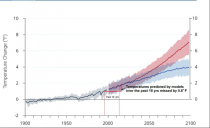
Figure 1. NDC temperature predictions
Facts: How do we check the validity of this prediction? Well, we can look at comparisons of previous computer model results to recorded satellite temperatures. Figure 2 shows Roy Spencer’s plot of 44 of the latest climate models versus satellite measurements. As his graph shows, the models were not even close to the real measured temperatures. The obvious conclusion here is that the models failed miserably, a fact admitted to by the IPCC in their latest report.
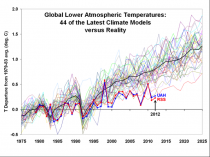
Figure 2. Temperatures from 44 of the latest computer climate models plotted against UAH and RSS satellite temperature measurements. The models weren’t even close! (Spencer, 2014) Enlarged
Well, maybe the graph from the 16 climate models used in the NDC report weren’t included in the 44 models in the Spencer plot, so let’s check their particular model results by looking at the 18 year period of overlap of the NDC model results and satellite measurements in Figure 1. The graph shows that the computer model predicted an increase of 0.8 F during the past 18 years when satellite measurements record no warming at all! That’s a huge difference over such a time period, the modeled results are nowhere near reality. If the model can’t come any closer than 0.8 F in 18 years, why should we believe that it is any more accurate over the next 86 years to the end of the century? The modeled temperature predictions fail verification from measured temperatures and thus fail the Feynman test “If it disagrees with the experiment, it is wrong.” We can therefore confidently conclude that the NDC temperature predictions are not valid.
At this point, we might ask, since virtually everything else in the NDC report is based on these computer models, doesn’t that invalidate all that follows? It certainly invalidates their dire predictions, but the report also contains assertions that are based on claims other than from models. Don goes on one by one examining their validity here and finds them sorely lacking.
Pat Michaels on Obama climate report National Climate Assessment: ‘I was one of the reviewers on the report. I have read dozens of these compendia on climate change and this was the worst one I have ever read in my life. It’s one sided, it ignores tremendous amounts of the scientific literature. It is a document designed to tell a story and to give the President an excuse for a policy that no one wants..It is a boneheaded report for a President that has a tin ear on this issue. The drum beat goes on and on and on.’
Francis J. Menton, Jr.
Attorney at Law
787 Seventh Avenue
New York, New York 10019
May 9,2014
The Honorable Regina McCarthy, Administrator
Environmental Protection Agency
Ariel Rios Building
1200 Pennsylvania Avenue, N.W.
Washington, D.C. 20460
Re: Docket ID No. EPA-HQ-OAR-2013-0495-2338,
Standards of Performance for Greenhouse Gas Emissions for New Stationary
Sources: Electric Utility Generating Units
Dear Administrator McCarthy:
This letter and its attachment are comments submitted for the proposed rulemaking regarding Standards of Performance for Greenhouse Gas Emissions for New Stationary Sources: Electric Utility Generating Units. In its “Summary,” EPA states: “This action will amend the new source performance standards (NSPS) for electric generating units (EGUs) and will establish the first NSPS for greenhouse gas (GHG) emissions. The rule will establish C02 emission standards for certain new and reconstructed fossil fuel-fired electric generating units.”
Please consider these “comments” in the development and selection of the final rule.
As you undoubtedly know, OMS is currently in the process of reviewing comments on the document known as “Technical Support Document: - Technical Update of the Social Cost of Carbon for Regulatory Impact Analysis - Under Executive Order 12866” ("TSO"). The TSD is designed and intended to become the basis for ongoing restriction on the use of carbon-based energy in the United States, whether through regulatory or legislative action.
I submitted one of the many letters of comment to OMS as part of its review process: A copy of my letter is attached. My letter points to several obvious aspects ofthe TSD that make it so clearly flawed as to call into question the fundamental honesty and ethics of this entire regulatory effort.
Most notably:
The TSD purports to rely on IPCC work as a basis for a supposed “sensitivity” of climate to increasing atmospheric C02, but fails to mention that the most recent IPCC report completely undermines any basis for determining climate sensitivity with the following statement: “No best estimate for equilibrium climate sensitivity can now be given because of a lack of agreement on values across assessed lines of evidence and studies.” This means that the IPCC admits that it does not have a credible mean, mode or median value of the equilibrium climate sensitivity parameter. In the mathematics of Decision Theory, this situation is called Complete Ignorance Uncertainty.
The TSD fails to note that EPA’s so-called “Endangerment Finding” of 2009 with regard to atmospheric C02 has. been invalidated by the failure of real world data to support each of the three “lines of evidence” on which EPA purported to rely in reaching its Finding.
The TSD calculates the supposed “social cost of carbon” by focusing almost entirely on supposed worldwide negative consequences of increasing C02; while completely ignoring and not even attempting to evaluate - the obvious major positives of carbon energy usage and increasing C02, such as making inexpensive energy accessible to the poor and increasing agricultural productivity.
In its current state, the TSD can only be described as fundamentally dishonest and unethical. I strongly urge you to rethink how such a completely dishonest and unethical effort, with potential enormous costs and consequences for the American people and the economy, has come to advance so far in the government’s processes. Clearly proposing a NSPS for greenhouse gas emissions makes absolutely no sense whatsoever in that such standard would then be based on both a grossly flawed Endangerment Finding and fatally flawed Social Cost of Carbon.
Please consider this letter in the development and selection of the final rule. Thank you for your consideration.
cc: Christian Fellner, Energy Strategies Group, Sector Policies and Programs Division,
EPA
Nick Hutson, Energy Strategies Group, Sector Policies and Programs Division, EPA
May 7th, 2014 by Roy W. Spencer, Ph. D.
There will be many comments from others, I’m sure, but these are my initial thoughts on the 12 major findings from the latest National Climate Assessment, which proports to tell us how the global climate change anticipated by the IPCC on a global basis will impact us here at home.
The NCA report findings are in bold and italics.
My comments follow each finding.
1. Global climate is changing and this is apparent across the United States in a wide range of observations. The global warming of the past 50 years is primarily due to human activities, predominantly the burning of fossil fuels. Many independent lines of evidence confirm that human activities are affecting climate in unprecedented ways. U.S. average temperature has increased by 1.3F to 1.9F since record keeping began in 1895; most of this increase has occurred since about 1970. The most recent decade was the warmest on record. Because human-induced warming is superimposed on a naturally varying climate, rising temperatures are not evenly distributed across the country or over time.
Yes, it has likely warmed, but by an amount which is unknown due to increasing warm biases in thermometer siting, which cannot be removed through “homogenization” adjustments. But there is no way to know whether “The global warming of the past 50 years is primarily due to human activities...”, because there is no fingerprint of human-caused versus naturally-caused climate change. To claim the changes are ‘unprecedented’ cannot be demonstrated with reliable data, and are contradicted by some published paleoclimate data which suggests most centuries experience substantial warming or cooling.
2. Some extreme weather and climate events have increased in recent decades, and new and stronger evidence confirms that some of these increases are related to human activities. Changes in extreme weather events are the primary way that most people experience climate change. Human-induced climate change has already increased the number and strength of some of these extreme events. Over the last 50 years, much of the United States has seen an increase in prolonged periods of excessively high temperatures, more heavy downpours, and in some regions, more severe droughts.
There is little or no evidence of increases in severe weather events, except possibly in heavy rainfall events, which would be consistent with modest warming. The statement panders to the publics’ focus on the latest severe weather, and limited memory of even worse events of the past.
3. Human-induced climate change is projected to continue, and it will accelerate significantly if global emissions of heat-trapping gases continue to increase. Heat-trapping gases already in the atmosphere have committed us to a hotter future with more climate-related impacts over the next few decades. The magnitude of climate change beyond the next few decades depends primarily on the amount of heat-trapping gases that human activities emit globally, now and in the future.
This is a predictive statement based upon climate models which have not even been able to hindcast past global temperatures, let alone forecast changes with any level of accuracy.
4. Impacts related to climate change are already evident in many sectors and are expected to become increasingly disruptive across the nation throughout this century and beyond. Climate change is already affecting societies and the natural world. Climate change interacts with other environmental and societal factors in ways that can either moderate or intensify these impacts. The types and magnitudes of impacts vary across the nation and through time. Children, the elderly, the sick, and the poor are especially vulnerable. There is mounting evidence that harm to the nation will increase substantially in the future unless global emissions of heat-trapping gases are greatly reduced.
To the extent climate has changed regionally, there is no way to know how much has been due to human activities. In fact, it might well be human-induced changes have reduced the negative impact of natural changes - there is simply no way to know. You see, those scientists who study the natural world cannot bring themselves to consider the possibility than some human impacts are actually positive. Even if the human-caused impacts are a net negative, they are far outweighed by the benefits to society (especially the poor) of access to abundant, affordable energy. Besides, for the next few decades, there is nothing substantial we can do about the problem, unless killing off a large portion of humanity, and making the rest miserable, is on the table.
5. Climate change threatens human health and well-being in many ways, including through more extreme weather events and wildfire, decreased air quality, and diseases transmitted by insects, food, and water. Climate change is increasing the risks of heat stress, respiratory stress from poor air quality, and the spread of waterborne diseases. Extreme weather events often lead to fatalities and a variety of health impacts on vulnerable populations, including impacts on mental health, such as anxiety and post-traumatic stress disorder. Large-scale changes in the environment due to climate change and extreme weather events are increasing the risk of the emergence or reemergence of health threats that are currently uncommon in the United States, such as dengue fever.
Most of this is just simply made up, and ignores the positive benefits of access to affordable energy which far outweigh the negatives. If there has been an increase in anxiety and PTSD, it isn’t from severe weather events...it’s from the relentless fear mongering by politicians and the news media.
6. Infrastructure is being damaged by sea level rise, heavy downpours, and extreme heat; damages are projected to increase with continued climate change. Sea level rise, storm surge, and heavy downpours, in combination with the pattern of continued development in coastal areas, are increasing damage to U.S. infrastructure including roads, buildings, and industrial facilities, and are also increasing risks to ports and coastal military installations. Flooding along rivers, lakes, and in cities following heavy downpours, prolonged rains, and rapid melting of snowpack is exceeding the limits of flood protection infrastructure designed for historical conditions. Extreme heat is damaging transportation infrastructure such as roads, rail lines, and airport runways.
Sea level rise (which was occurring before we started emitting carbon dioxide in substantial amounts) is a very slow process, which would have to be accommodated for anyway. And the weaker global warming turns out to be, the slower sea level rise will be. Infrastructure damage occurs anyway, and is often due to weather events which exceed the design limits. You don’t engineer roads and buildings and seawalls and levees to handle any possible scenario...it would be too expensive. A large part of our flooding problems are due to the replacement of natural ground with paved surfaces, which enhances runoff into rivers. This has nothing to do with climate change.
7. Water quality and water supply reliability are jeopardized by climate change in a variety of ways that affect ecosystems and livelihoods. Surface and groundwater supplies in some regions are already stressed by increasing demand for water as well as declining runoff and groundwater recharge. In some regions, particularly the southern part of the country and the Caribbean and Pacific Islands, climate change is increasing the likelihood of water shortages and competition for water among its many uses. Water quality is diminishing in many areas, particularly due to increasing sediment and contaminant concentrations after heavy downpours.
This is largely a non sequitur. The problems described exist even without human-caused climate change...to the extent that substantial human influences exist.
8. Climate disruptions to agriculture have been increasing and are projected to become more severe over this century. Some areas are already experiencing climate-related disruptions, particularly due to extreme weather events. While some U.S. regions and some types of agricultural production will be relatively resilient to climate change over the next 25 years or so, others will increasingly suffer from stresses due to extreme heat, drought, disease, and heavy downpours. From mid-century on, climate change is projected to have more negative impacts on crops and livestock across the country, a trend that could diminish the security of our food supply.
I work with the people involved in tracking and long-term prediction of agricultural yields, both domestically and internationally. They see no sign of climate change impacts on agricultural yields. There are always natural fluctuations, but if there is any negative human-induced impact, it is swamped by the increasing yields due to improved agricultural practices, seed varieties, and very likely CO2 fertilization.
9. Climate change poses particular threats to Indigenous Peoples’ health, well-being, and ways of life. Chronic stresses such as extreme poverty are being exacerbated by climate change impacts such as reduced access to traditional foods, decreased water quality, and increasing exposure to health and safety hazards. In parts of Alaska, Louisiana, the Pacific Islands, and other coastal locations, climate change impacts (through erosion and inundation) are so severe that some communities are already relocating from historical homelands to which their traditions and cultural identities are tied. Particularly in Alaska, the rapid pace of temperature rise, ice and snow melt, and permafrost thaw are significantly affecting critical infrastructure and traditional livelihoods.
O..M..G. So lets help poor people by increasing the cost of everything by making the energy on which everything depends even more expensive? The people who write this drivel are so clueless they should not be allowed to influence the decision making process.
10. Ecosystems and the benefits they provide to society are being affected by climate change. The capacity of ecosystems to buffer the impacts of extreme events like fires, floods, and severe storms is being overwhelmed. Climate change impacts on biodiversity are already being observed in alteration of the timing of critical biological events such as spring bud burst and substantial range shifts of many species. In the longer term, there is an increased risk of species extinction. These changes have social, cultural, and economic effects. Events such as droughts, floods, wildfires, and pest outbreaks associated with climate change (for example, bark beetles in the West) are already disrupting ecosystems. These changes limit the capacity of ecosystems, such as forests, barrier beaches, and wetlands, to continue to play important roles in reducing the impacts of these extreme events on infrastructure, human communities, and other valued resources.
Modest warming and more CO2 available to the biosphere is already having positive impacts, such as the recent greening of the planet. Trying to turn the most obvious positive outcomes into negatives leads to logical contortions which would be funny if they weren’t so serious. Nature changes anyway, folks, as evidenced by glaciers in Europe and North America receding and uncovering ancient tree stumps. Ecosystems are being “overwhelmed”? I don’t think so. Ecosystems are not static.
11. Ocean waters are becoming warmer and more acidic, broadly affecting ocean circulation, chemistry, ecosystems, and marine life. More acidic waters inhibit the formation of shells, skeletons, and coral reefs. Warmer waters harm coral reefs and alter the distribution, abundance, and productivity of many marine species. The rising temperature and changing chemistry of ocean water combine with other stresses, such as overfishing and coastal and marine pollution, to alter marine-based food production and harm fishing communities.
There is increasing evidence that ocean acidification has been greatly overblown. I’m not an expert, but from what I’ve read lately, more realistic lab experiments with adding CO2 to sea water shows that the natural buffering capacity of sea water limits pH changes, and the increasing CO2 is actually good for life in the ocean...just as it is on land (because CO2 is also necessary for the start of the food chain in the ocean). I think the jury is still out on this issue...but, of course, we can’t expect government reports, which are written to facilitate desired policy changes, to provide balance on such things.
12. Planning for adaptation (to address and prepare for impacts) and mitigation (to reduce future climate change, for example by cutting emissions) is becoming more widespread, but current implementation efforts are insufficient to avoid increasingly negative social, environmental, and economic consequences. Actions to reduce emissions, increase carbon uptake, adapt to a changing climate, and increase resilience to impacts that are unavoidable can improve public health, economic development, ecosystem protection, and quality of life.
Translation: We need more government regulation and taxation.
THE BOTTOM LINE:
Follow the money, folks. This glitzy, 840-page report took a lot of your tax dollars to generate, and involved only those “experts” who are willing to play the game. It is difficult to answer in its entirety because government has billions of dollars to invest in this, while most of us who try to bring some sanity to the issue must do it in our spare time, because we aren’t paid to do it. It is nowhere near balanced regarding science, costs-versus-benefits, or implied policy outcomes. Like the previous two National Assessment reports, it takes global climate models which cannot even hindcast what has happened before, which over-forecast global average warming, which are known to have essentially zero skill for regional (e.g. U.S.) predictions, and uses them anyway to instill fear into the masses, so that we might be led to safety by politicians.
Caveat emptor.
(Oh, and if you are tempted to say, “What about all the Big Oil money involved in our need for energy?” Well, that money was willingly given to Big Oil by all of us for a useful product that makes our lives better. Government money is taken from you (I’m not anti-taxation, just pointing out a distinction) that they then use to perpetuate the perceived need for more government control. If “Big Oil” could make a profit by becoming
“Big Solar”, or “Big Wind”, they would.)





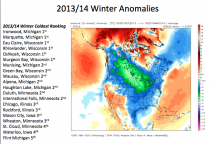
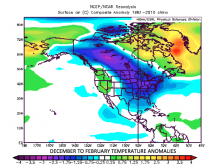
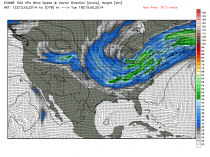
_thumb.png)
_thumb.png)
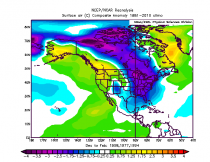
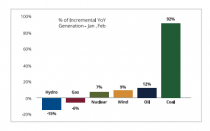

_thumb.jpg)
